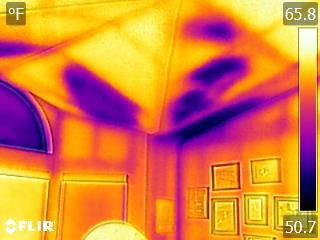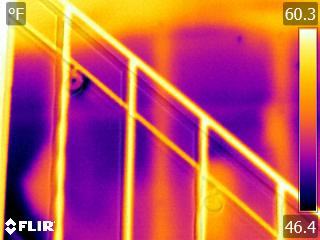Infrared Thermography
Thermal imaging
Inspecting buildings using a thermal imaging camera is a powerful and non invasive means of monitoring and diagnosing the condition of buildings. Thermal imaging technology has become one of the most valuable diagnostic tools for building exams. Using a thermal imaging camera can identify problems early, allowing them to be documented and corrected before becoming more serious and more costly to repair.
A Home Performance Diagnostics with a thermal imaging camera can help:
- Visualize energy losses
- Detect missing or defective insulation
- Locate the source of air leaks
- Find moisture in insulation, in roofs and walls, both in the internal and the external structure
- Detect mold prone (i.e. wet) areas
- Locate thermal bridges
- Locate water infiltration in flat roofs
- Detect breaches in hot-water pipes
- Detect construction failures
What does Infrared Thermography equipment do?
Thermography involve the detection of Infrared (IR) electromagnetic radiation emitted by an object. The camera captures an image as a temperature distribution on a surface and it can display it as a visible information. Additionally, temperatures can be measured from a distance without contacting an object and can be measured in real time.
Although it may appear that we can look into walls, the reality is that we are only seeing surface temperatures. However, these do imply what is happening behind the wall, but occasionally we must peek into a wall section to figure out what is actually happening.
Merits of Infrared Thermography equipment
Relative comparison of distribution of surface temperature can be made over a wide area. Temperature can be measured easily for a moving object or an object which is too dangerous to get close to. Temperature of small object can be measured without confusing the temperature. Without opening up your walls or ceilings for examination, a trained specialist can use one of these cameras to locate insulation voids, air leaks, moisture intrusion, thermal bypasses, and thermal bridges. It is even possible to use an infrared camera to locate leaks in hydronic tubing embedded in a slab.
Infrared Thermography uses in Buildings
The use of thermal infrared imaging is a valuable tool for diagnosing and performing non-destructive testing of building elements. Thermography can be used to detect heat losses, missing or damaged thermal insulation in walls and roofs, thermal bridges, air leakage and moisture sources. As a result, interventions can be well targeted with a reduced repair cost, while saving heating and cooling costs. Difficult to access HVAC installations can also be examined. For example, IR imaging can be used to distinguish air supply and exhaust outlets from hard to reach ceiling diffusers and determine their operational status. It is also possible to locate and trace hot and cold pipes inside building elements (i.e. floor piping in water heating systems), to identify the loops and minimize the guesswork when there is a need to replace them, to check for heat losses as a result of poorly insulated pipes and ducts, etc.
How an Infrared Thermographer uses the camera
A thermographer scans surfaces for anomalies, such as insulation voids or moisture issues. After an initial scan, most thermographers set up a blower door to depressurize the building. The thermographer then does a second scan looking for new anomalies, typically air leakage.
The blower door increases the flow rate of air leaking into the building through cracks in the walls, floors, and ceiling. Since the outdoor air is at a different temperature from the indoor air, the air cools (or warms) the surfaces it encounters in the area of the crack, creating visible plumes in thermal images. For example, during the heating season the resulting sites of air infiltration appear cooler. The examination can be done any time of year the indoor/outdoor temperature difference is greater than a few degrees.
The thermal image for air leakage will appear as "fingers" or "streaking" showing as dark when cold air is observed and lighter colors when warm air is viewed. The thermal images will produce irregular shapes with uneven boundaries and large temperature variations. These air leakage sites are often at joints, junctions or penetrations in the enclosure. There is often a temperature gradient within a finger or streaking area.
Thermography for evaluating HVAC performance
HVAC systems can be plagued by design and installation problems resulting in excessive energy use and/or uncomfortable buildings. Thermography helps Home Performance Analyst visualize the otherwise invisible impact of this poor performance as indicated by excessively hot or cold areas. Once these have been located, the root causes can be determined; these may include reversed or misdirected airflow or poorly placed supply ducts, leading to short-circuiting of air directly to the return ducts



Interesting Links
FLIR booklet - Thermal Imaging for Building Diagnostics -or- Cached copy
IRinfo.org - Infrared Applications in Building Diagnostics
